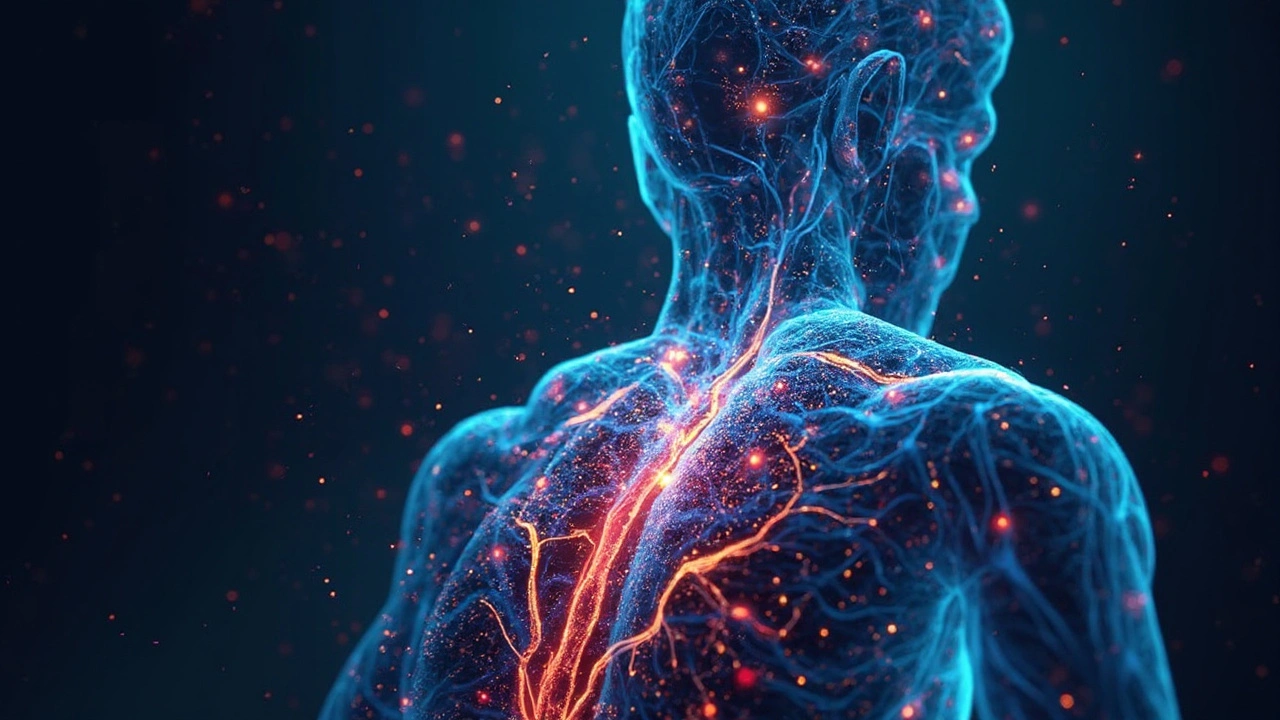Neuromuscular Massage: Incredible Benefits for Your Body
 Feb, 18 2025
Feb, 18 2025
Have you ever wondered why neuromuscular massage is gaining popularity among athletes and busy folks alike? It's not just about relaxation—it's a powerful therapeutic approach targeting the source of your pain and muscle discomfort. Think of it like a specialized tune-up for your body.
So, what exactly is going on during this type of massage? The therapist zeroes in on trigger points and areas of strain to help release tension. This isn't a one-size-fits-all therapy; it's meticulously tailored to address your specific needs, helping to rejuvenate stressed areas.
Besides easing tension, neuromuscular massage helps improve circulation and boost muscle flexibility. Imagine reducing that nagging back pain or the tightness in your shoulders after a long workweek. Sounds like a dream, right? As a bonus, it might even enhance your mood.
- Understanding Neuromuscular Massage
- Key Benefits to Muscle Health
- Pain Relief and Rehabilitation
- Techniques and Practices
- Getting Started with Neuromuscular Massage
Understanding Neuromuscular Massage
The world of massages can be a bit overwhelming, right? But when it comes to targeting specific issues like chronic pain and muscular problems, a neuromuscular massage might be just what you need. It's a specialized technique, often rooted in anatomical knowledge and clinical applications, aimed at balancing the nervous and muscular systems.
Unlike a regular massage, which focuses mainly on relaxation, neuromuscular massage zeroes in on the root cause of your pain. It involves the application of pressure to specific muscles, tendons, and connective tissues. The goal here is not only to loosen the muscles but also to improve circulation and nerve transmission, vital for muscle health and recovery.
Core Principles
At its core, neuromuscular massage works on trigger points—those knotted spots in your muscles that can cause pain in another area, known as referred pain. Skilled therapists apply varying pressure techniques to release these points, effectively managing and reducing pain.
Here’s a neat fact: neuromuscular therapy also takes into account postural distortion. This is when your regular posture starts affecting muscle efficiency, leading to different imbalances that the therapist will address during your sessions, potentially helping with persistent aches.
Who Can Benefit?
- Athletes looking to enhance performance and recover from injuries.
- Office workers dealing with repetitive stress injuries.
- People suffering from chronic conditions like fibromyalgia.
Statistics even show that many clients notice improvements in their posture and range of motion after consistent sessions.
To dig a bit deeper, think of therapists as detectives. They assess your posture, movement, and even emotional health to create a truly customized plan. Whether you're dealing with acute injuries or long-term issues, neuromuscular massage has proven to be a versatile tool in facilitating overall well-being.
Key Benefits to Muscle Health
If you’re dealing with muscle tightness, whether from a marathon Netflix binge or a real marathon, you might be surprised by the wonders a neuromuscular massage can work. Unlike your run-of-the-mill relaxation massage, this therapeutic technique pinpoints muscle issues, providing deep relief and promoting muscle health.
Improved Blood Circulation
Getting a neuromuscular massage can jumpstart your circulation. This means more oxygen and nutrients travel to your muscles, helping them repair and grow stronger. It's a natural way to enhance muscle health and function.
Pain Reduction
Neuromuscular massage is known for its ability to target and relieve pain. When the therapist works on your muscles, they help break up knotted tissue, which can alleviate discomfort and improve your range of motion. And who doesn't want to move a bit more freely?
Enhanced Muscle Recovery
For those who push their bodies to the limit, such as athletes or gym enthusiasts, a massage can speed up the recovery process. By reducing toxins and increasing flexibility, neuromuscular massage assists in muscle healing and lessens the chance of injury.
Stress and Tension Reduction
Muscular health isn't just about physical strain; mental stress mounts tension, too. Regular massages can help manage stress levels, providing a much-needed reset for both mind and body.
Moreover, according to a 2023 study by Sports Body Review, regular neuromuscular massages can improve muscle flexibility by as much as 20%. This is particularly beneficial for anyone involved in activities that require a wide range of motion.
Incorporating neuromuscular massage in your routine might just be the boost your muscles need, leading to a healthier, pain-free lifestyle.

Pain Relief and Rehabilitation
Ever had that one persistent pain that just won't quit? Neuromuscular massage might be the answer you never knew you needed. It's not about masking the pain but tackling it head-on. By targeting specific areas known as trigger points, this therapy helps alleviate aches that traditional methods often overlook.
Why focus on trigger points, you ask? These are spots within tight muscle fibers that can cause pain in other parts of your body. Think of them as the culprits behind mysterious, nagging discomfort. Neuromuscular therapists are like detectives, zeroing in on these points, which can make a world of difference.
How Does It Work?
During a session, the therapist applies precise pressure on affected spots, stimulating blood flow and relieving pressure. This not only reduces pain but also improves movement and flexibility over time. Regular sessions might help you steer clear of muscle injuries and cramps, especially if you're active.
“Neuromuscular massage targets the anatomy of pain, not just the symptoms, offering a deeper solution,” says renowned therapy expert Dr. Sarah Collins.
Massage benefits extend beyond just relief. It's about rehabilitation. Many clients report significant improvements in mobility and pain management after only a few sessions. Isn’t it fascinating that something as natural as touch can aid in healing?
To give you some context, here's a simple breakdown:
| Condition | Improvement Rate |
|---|---|
| Lower back pain | 70% report improvement |
| Neck tension | 65% notice relief |
| Flexibility issues | 60% improved range |
Convinced yet? Whether it's chronic pains or just the twinges from a hard day's work, neuromuscular massage is a natural ally in your recovery journey.
Techniques and Practices
When it comes to neuromuscular massage, the methods used are as unique as the people receiving them. A typical session involves a blend of techniques that focus on deep tissue work, targeting specific muscle groups to alleviate pain and tension.
Deep Tissue Techniques
One of the core components of this massage is deep tissue work. This involves applying firm pressure and slow strokes to reach deeper layers of muscle and fascia. The aim here is to break down knots and relieve chronic muscle tension. Don’t be surprised if it’s a bit intense at times—it's all part of the process!
Trigger Point Therapy
This method zeroes in on specific ‘trigger points.’ These are sensitive spots in connective tissue that can cause pain elsewhere in the body. By applying precise pressure to these areas, the therapist can help relieve referred pain and improve mobility.
Application Process
The actual application of these techniques is crucial. Therapists often incorporate a combination of their hands, elbows, or even tools to apply adequate pressure. Here’s a simple breakdown of what happens during a session:
- Assessment: A brief examination to identify problem areas.
- Pressure Application: The therapist uses deep and controlled strokes to affect deeper tissues.
- Trigger Point Focus: Specific attention to areas causing pain, sometimes holding pressure for up to 10 seconds.
- Feedback Cycle: Continuous check-ins with the client to ensure comfort and effectiveness.
Regular Practice and Benefits
Many find that integrating these techniques into their wellness routine offers long-term benefits. On average, regular sessions lead to improved muscle health, enhanced range of motion, and a notable reduction in pain levels. It's like having a personal maintenance routine for your muscles!

Getting Started with Neuromuscular Massage
Embarking on your neuromuscular massage journey is all about finding the right therapist and understanding what this therapy can do for you. Let's break it down, so you feel ready and informed before stepping into your first session.
Research and Find a Qualified Therapist
Start by researching skilled therapists in your area. Look for professionals who specialize in neuromuscular techniques. Don't hesitate to read reviews or ask for recommendations from friends who have experience with this type of massage. Credentials matter! Ensure your therapist has the proper training and certification.
“Neuromuscular therapy is a holistic approach to correcting pain. It's about finding where the problem starts in the body and helping it heal.” — Dr. Sarah Paulson, Certified Massage Therapist
Preparing for Your First Session
Going in for a session? Make sure you're hydrated. Drinking plenty of water before helps your muscles respond better to the treatment. Wear comfy, loose-fitting clothing that can be easily removed for your massage.
What to Expect During the Session
Your therapist will likely start with a brief consultation to understand your specific needs. They’ll focus on areas where you feel tension or discomfort. Don't be surprised if the pressure is a bit more intense than a regular massage—this is by design to help release tightly bound muscle fibers.
During the session, communicate with your therapist. If something feels uncomfortable or too intense, let them know. Your comfort is key to getting the most out of neuromuscular therapy.
Aftercare Tips
- Rest Up: Give your body a chance to rest and heal post-session. It's normal to feel a tad sore.
- Stay Hydrated: Water helps flush out toxins released during the massage.
- Stretch: Gentle stretching can keep your muscles loose and improve results.
Kick-off your journey with a positive mindset. Regular sessions could transform not just your physical well-being, but your overall sense of mental calm. Ready to feel the difference?
